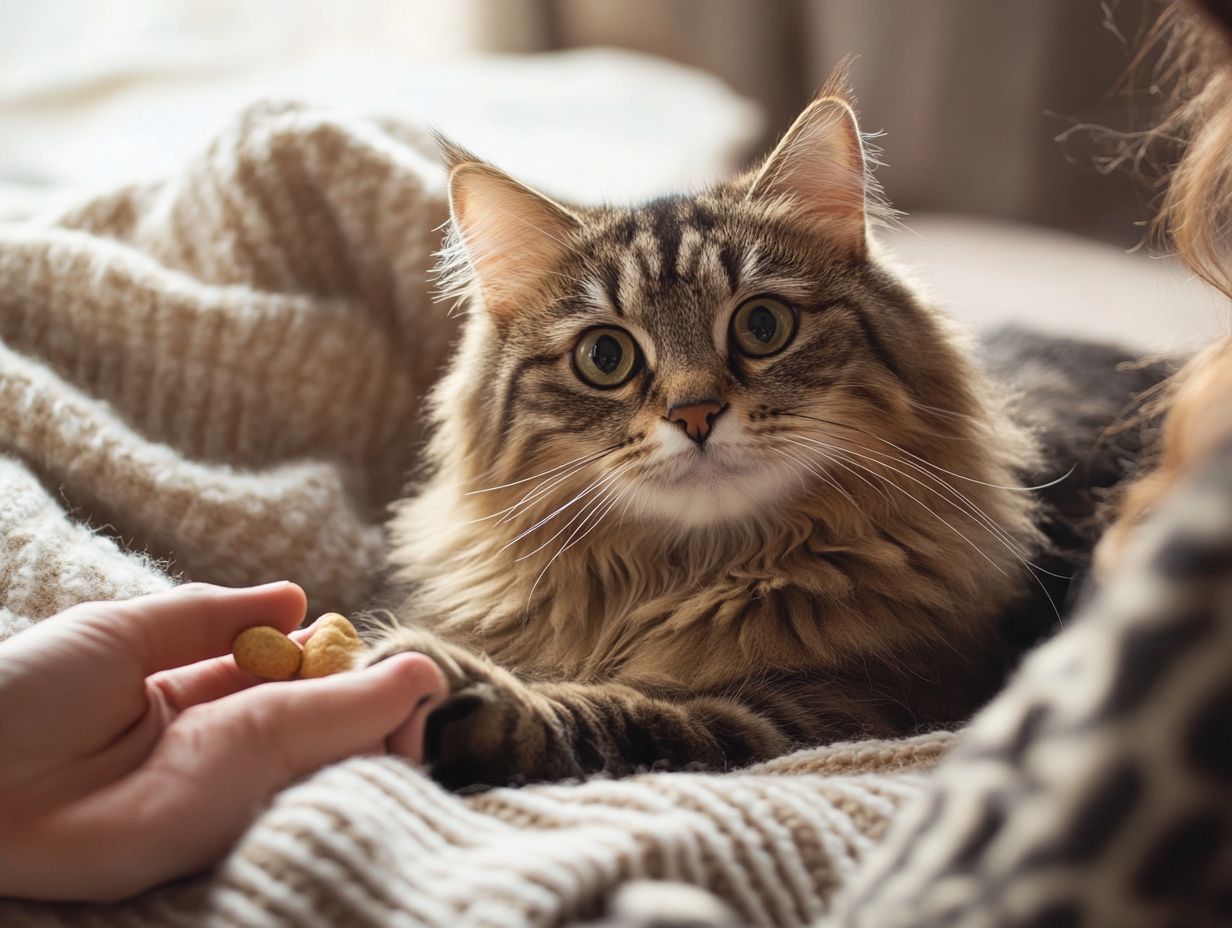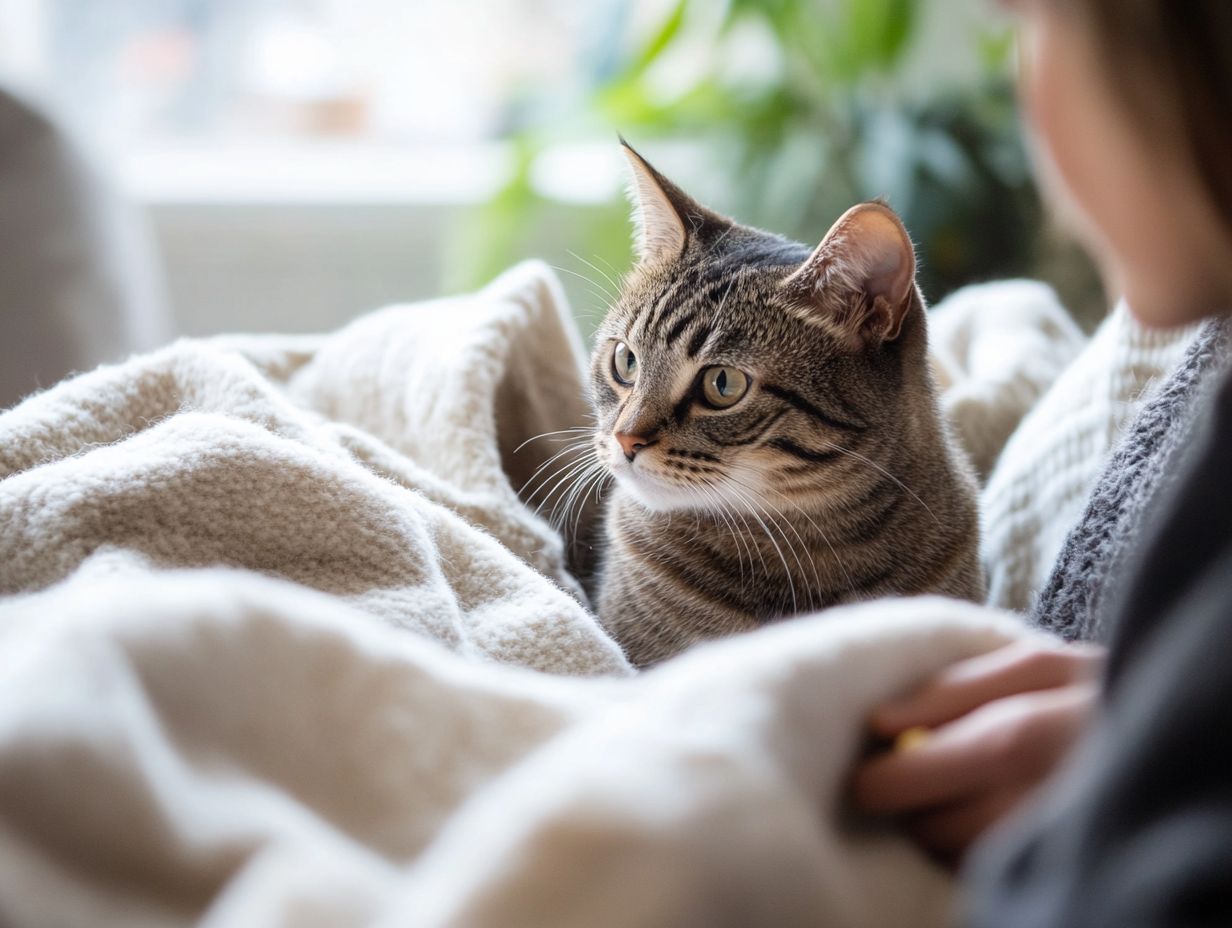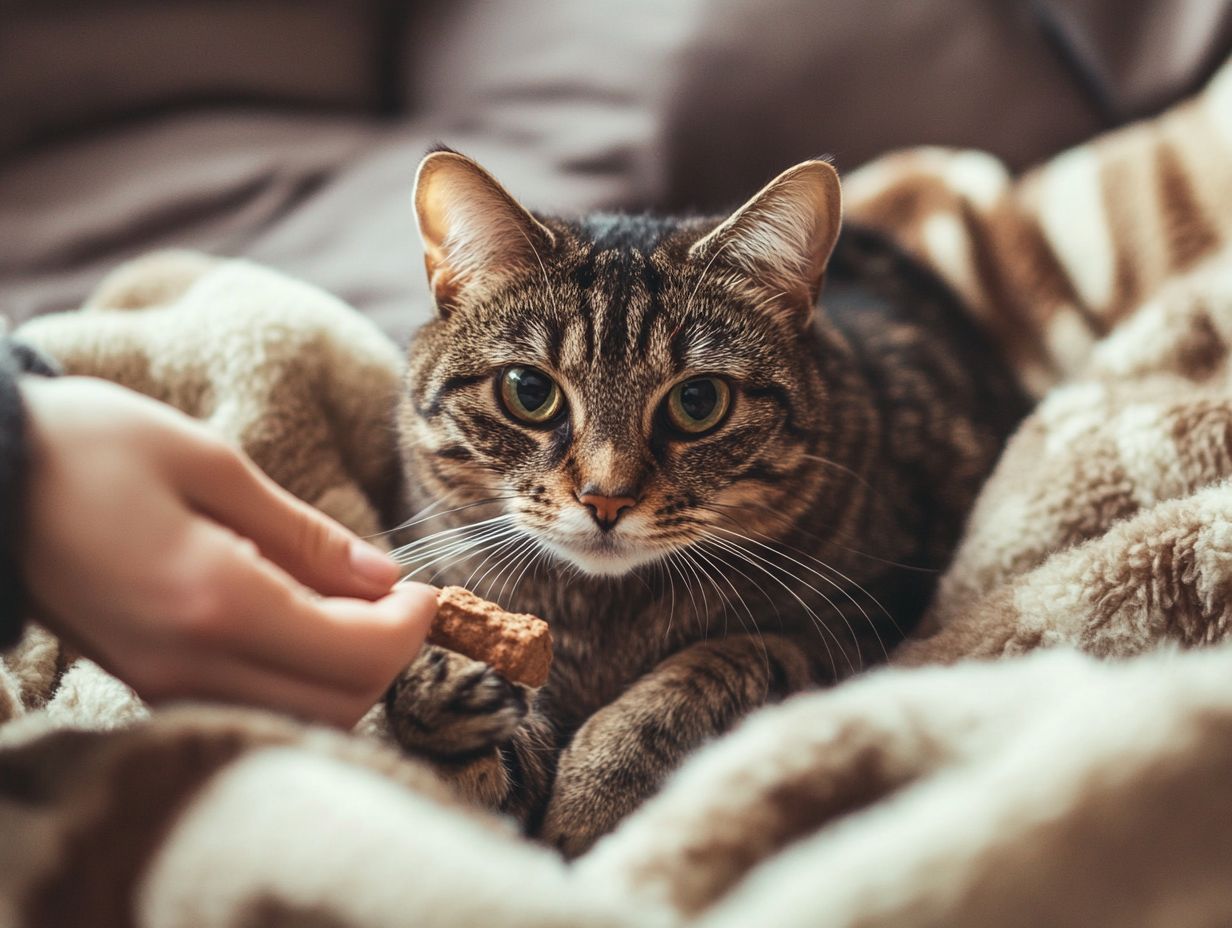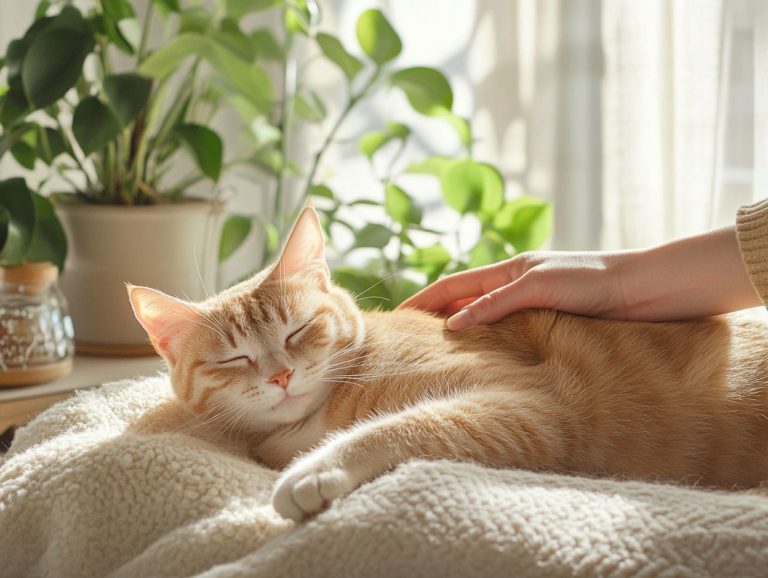Tips for Training Cats with Anxiety Issues
Cats, much like people, can experience anxiety, though their signs may not always be readily apparent.
Understanding the causes and common triggers of cat anxiety is essential for any pet owner keen on creating a soothing environment for their furry companion. This guide will help you identify changes in behavior that may indicate distress, create a calming space, and implement effective training techniques to ease their worries.
You ll also discover alternative therapies, including herbal remedies, and the importance of seeking guidance from a veterinarian. Your feline friend deserves a life free from stress, and with the right approach, support is vital!
Contents
Key Takeaways:

- Identify the causes and triggers of your cat’s anxiety to better understand their behavior and provide appropriate training.
- Be aware of changes in behavior, such as excessive grooming or hiding, as they may indicate anxiety.
- Create a calm and stress-free environment for your cat by providing safe spaces and incorporating stress-reducing techniques like playtime and music.
Understanding Cat Anxiety
Understanding cat anxiety requires recognizing many causes that can influence your feline friend’s state of mind. This may manifest in behaviors such as hiding, excessive vocalization, or even urination issues.
Environmental stressors, changes in the home, and past traumas can all contribute to these anxiety symptoms, making careful observation essential. Implementing effective anxiety management techniques is crucial.
By creating a serene environment and exploring natural remedies or calming products, you can significantly support your anxious cat and enhance their overall well-being.
Causes and Common Triggers
Common causes and triggers of cat anxiety often originate from environmental stressors, ownership disputes, or even traumatic experiences that affect a cat s sense of safety in their own home.
When you change routines like moving to a new place or welcoming new pets or family members it can create a sense of instability that many felines struggle to navigate. Noisy environments, like construction sites or loud music, can overwhelm sensitive cats, further amplifying their stress levels.
Socialization or the lack thereof plays a pivotal role in this equation. The more your cat is exposed to varied experiences and environments, the better equipped they become to handle anxiety.
By engaging in activities that encourage social interaction, whether through playful moments or gentle introductions to new companions, you can significantly alleviate symptoms and foster a reassuring sense of security for your feline friend.
Signs and Symptoms of Cat Anxiety

Recognizing the signs and symptoms of cat anxiety is essential for prompt intervention and effective treatment. An anxious cat might display behaviors such as excessive grooming, hiding, vocalizing more than usual, or scratching, all of which can signal underlying emotional distress or health concerns.
By understanding these anxiety symptoms, you can seek appropriate assistance from veterinary behaviorists or specialists, ensuring that your feline companion receives the care and support they truly deserve.
Identifying Behavioral Changes
Identifying behavioral changes in your cat is essential for addressing their anxiety. You might notice excessive meowing, signs of separation anxiety, or even withdrawal from family interactions.
Recognizing these shifts in behavior is crucial. They provide valuable insights into your cat’s emotional state and overall well-being. For instance, if your typically playful cat suddenly becomes lethargic or avoids its favorite spots, it could be a sign of stress or discomfort.
A cozy nook with soft blankets and familiar toys can work wonders for your cat s happiness! Consider adding calming scents like lavender to soothe their senses.
Using comfort items like a cherished scratching post or cuddle buddy can further ease their anxiety. By observing these changes and taking proactive steps, you nurture a sense of security for your cat and strengthen your unique bond.
Creating a Safe and Calming Environment
A safe and calming environment for your anxious cat is essential for alleviating anxiety symptoms and improving their overall quality of life.
Arrange your living space with comforting elements, such as a cat tree, soothing music, and pheromone diffusers. These create a sense of security.
Incorporate interactive toys to enhance mental stimulation. They help reduce stress and promote a tranquil atmosphere for your feline companion.
Tips for Reducing Stress

Implementing strategies to reduce stress can greatly enhance your cat’s emotional well-being, alleviating anxiety symptoms and promoting a happier, healthier life.
Incorporate playful activities into your cat’s daily routine. Try food puzzles or treasure hunts. These stimulate their minds and add adventure, reducing boredom and frustration.
Calming products like catnip can soothe nervous dispositions, making it easier for them to unwind. Regular interactive play fosters a strong bond with your feline friend and helps them release pent-up energy.
Prioritize these steps to boost your cat’s mental health and happiness!
Training Techniques for Anxious Cats
Training techniques for anxious cats are crucial in managing anxiety symptoms and enhancing their behavior. Focus on methods like positive reinforcement, desensitization, and counterconditioning, along with top training techniques to reduce pet anxiety. These foster a sense of security and trust.
Positive Reinforcement and Desensitization
Positive reinforcement and desensitization are key in training anxious pets. For instance, using tips for training an anxious dog in public can help cultivate trust and diminish fear responses over time.
Use rewards like treats or affection when your feline exhibits desired behaviors. This encourages confidence and reinforces positive actions. For example, when your cat approaches a new toy, offer a gentle stroke or a small treat to create a positive association.
Desensitization involves gradually getting your cat used to anxiety-inducing stimuli in a controlled manner, allowing it to adapt without feeling overwhelmed.
Behavioral specialists can provide tailored guidance to help you implement these techniques effectively and ensure sustainable progress. By combining structured support with consistent reinforcement, you can create a nurturing environment that significantly alleviates your pet s anxiety.
Alternative Therapies for Cat Anxiety

Alternative therapies for cat anxiety present a wealth of options that can offer significant relief. You can explore natural remedies, calming products, and, when necessary, even medication to ensure a comprehensive approach to managing your cat’s anxiety.
For many cat owners, diving into alternative therapies is an essential step toward helping their beloved companions feel safe and less stressed in their environments. Herbal supplements like chamomile and valerian root are particularly effective for promoting relaxation. Calming collars infused with pheromones create a soothing atmosphere that can work wonders.
Interactive toys are fun distractions that can help reduce stress levels. If your cat’s anxiety symptoms are severe or persistent, consulting a veterinarian about the possibility of medication may be a prudent choice. Striking the right balance among these various approaches ensures that your cat receives the tailored care they need to thrive.
Herbal Remedies and Supplements
Herbal remedies and supplements can be a game-changer for anxious cats, offering natural solutions that encourage relaxation and alleviate stress.
Adding these supplements to your cat’s routine is easy and rewarding! Popular options like valerian root, chamomile, and passionflower are celebrated for their calming effects, helping to ease your restless pet during stressful situations like thunderstorms or trips to the vet. You might consider mixing these herbs into treats or using specially formulated drops for more straightforward administration.
If you’re eager to explore the variety of options available, resources such as the American Association of Feline Practitioners and reputable pet wellness websites offer comprehensive guides on the benefits and appropriate dosages of these natural remedies.
Consulting with a Veterinarian
Consulting with a veterinarian or veterinary behaviorist (a veterinarian who specializes in animal behavior) is crucial for addressing any underlying health issues and determining the most effective anxiety management strategies for your cat. Their expert guidance is invaluable in identifying physical ailments, such as chronic pain or hormonal imbalances, that may be contributing to your feline friend’s heightened anxiety levels.
A thorough evaluation can help rule out medical conditions that could be exacerbating your pet’s stress, ensuring that any treatment plan effectively targets the root causes. When behavioral issues arise, the insights of a professional can lead you to tailored medication options that may alleviate symptoms for your cat.
Recognizing when to seek specialized help is essential. If your cat s anxiety appears persistent or worsens despite initial interventions, reaching out to a certified professional can significantly enhance your pet’s overall well-being.
Frequently Asked Questions
What are some tips for training cats with anxiety issues?
1. Start with a calm and patient approach. Cats with anxiety may take longer to learn new behaviors, so it’s important to be patient and understanding during training. For further guidance, check out best practices for pet anxiety training.
2. Use positive reinforcement techniques. Reward your cat with treats or praise when they exhibit calm and relaxed behaviors.
3. Establish a routine. Cats with anxiety can benefit from a set schedule, as it helps them feel more secure and in control.
4. Create a safe and comfortable environment. Make sure your cat has a quiet and comfortable space where they can retreat to if they feel overwhelmed.
5. Use pheromone products. Products like Feliway can help reduce anxiety in cats and make training easier. Additionally, consider using clicker training to alleviate anxiety.
6. Seek professional help if needed. If your cat’s anxiety issues are severe, consider consulting a professional animal behaviorist for additional guidance and support.






